Highlights
In this article I’ll describe my experience freediving the Blue Hole and discovering rock climbing in Dahab’s desert canyons. I’ll give you a few local tips on good spots to freedive and rock climb.
In this article I’ll cover:
- The perfect combination in travel: freediving and rock climbing
- Why doing both activities can improve your freediving game
- Great spots to freedive in and around Dahab
- Miguel Lozano’s Training Camp 2020 experience
- Rock climbing in the hidden canyons in the desert
- My 10 tips for freediving and climbing in Dahab
Reading Time: 8 minutes
Freediving in Dahab
The Blue Hole
This first night I arrived to Dahab I couldn’t sleep well. I woke up at 4:30AM to the sound of the early morning prayer in the distant background. I put on my running shoes and started jogging north.
Not quite sure how far or how long it would take me to get there, I was hoping to see my first sunrise at the Blue Hole. Turns out it was further than I thought. As I ran the last few kilometres, the local camels watch me go by, not bothering to move from the the middle of the road.
Sunrise at 6:30AM.
All by myself, no tourists (especially thanks to travel during the COVID pandemic), I had the Blue Hole all to myself.
Tip #1: Rent a mountain bike if you want to “self-propel” your way to the Blue Hole. In general, a bicycle in Dahab is very useful.
A collapsed sinkhole, the Blue Hole extends down to 100 meters (330 feet) immediately from shore. It’s breath-taking. Protected, few waves and barely any current, it’s truly a freediver’s paradise. However, we cannot forget it’s really in the middle of nowhere.
When you get there
A 20-minute car ride from nearby Dahab, which in itself is a small town. This must be taken into account if you’re a deep freediver. If something were to happen, can you ensure proper rescue, safety and emergency response resources are present?
A few things to know about getting to the Blue Hole:
- On average a taxi driver for a half-day will run you 200-250 Egyptian Pounds. Go ahead give a tip.
- Relax and get ready at the freediver “hangout“: AquaMarina restaurant. Ali and Mohammed will take care of you with special coffee and teas.
- Entrance fee is 5 $USD (about 80 Egyptian Pounds). Bring change. Sometimes instructors don’t pay, so bring your card if you have one.
- If you’re the first one out, it’s up to you to tether the long surface line from one end of the Blue Hole to the other.
Tip #2: This one’s obvious, but learn to say a few things in Egyptian Arabic. It’s crazy useful, polite and the locals really appreciate it. In fact, it might save you some money.
Please use proper judgement, connect with a local freediving school such as Dahab Freedivers and dive with professional instructors/coaches.
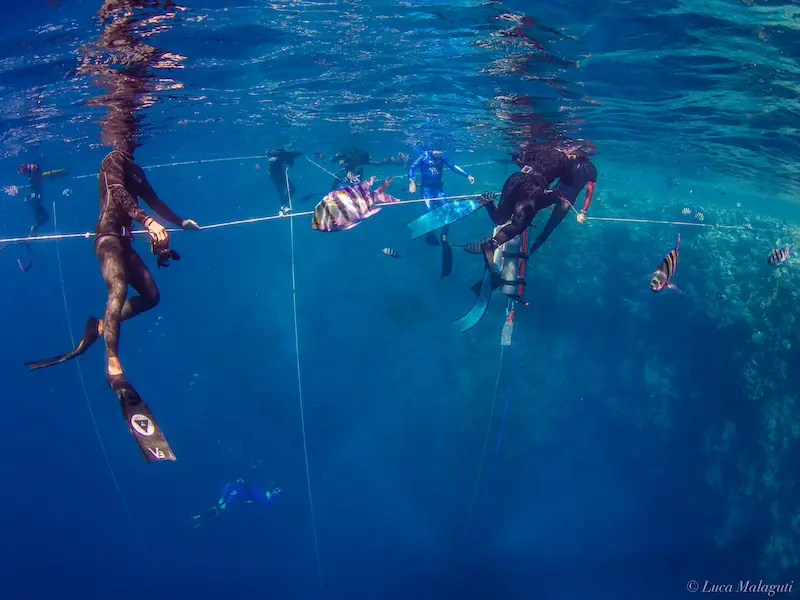
As a freediver, lying calmly above 100 meters (330 feet) over water is a special feeling. The Blue Hole isn’t all that large. It spans about 35-45 meters (110-140 feet) in diameter, and it’s more elliptical than circular.
The most fascinating part is at the deepest end (as seen in the above picture). The drop goes from 0.5 meters deep (1-2 feet of water) immediately down to the maximum depth.
Tip #3: Go freediving in the Blue Hole with qualified instructors/buddies, the proper line diving gear and respect the marine wildlife and coral reefs.
The Canyon
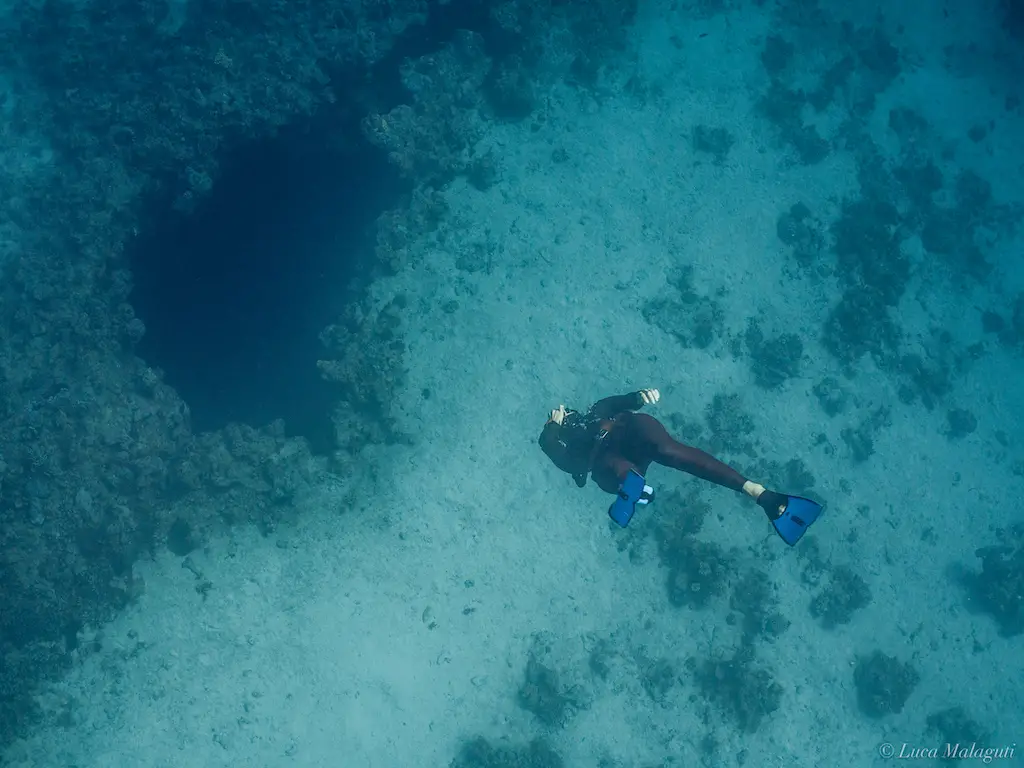
Another stunning, and often overlooked dive site, is “The Canyon“. The Canyon, as the name states, is a submerged canyon that begins at about 15 meters (50 feet) and extends down to 40 meters (130 feet) and deeper.
The Canyon is filled with marine wildlife and stunning coral formations. It’s also always full of scuba divers, so has a freediver you can enjoy the panorama of bubbles as you dive.
The issue with this location as a freediver is you are very much exposed to a few hazards.
These have to be considered in you dive plan:
- Current: strong currents moving you away from the dive site
- Wind and waves: difficult to buddy spot and your get tired easily
- Boat traffic: several fishing boats speed nearby
- Exposure and distance: you’re further from the shore
The Canyon is an underwater videographer’s dream. You can enter the narrow passage at the very top, known as the “Fish Bowl”. From here, you make your way deeper into this narrow canyon, with a varying opening at the top.
Once you’ve passed the “Fish Bowl”, the canyon opens up to the surface, allowing you to exit at any time. Check out the above video for my entry into the Fish Bowl.
Tip #4: Please make sure you’re an experienced freediver with proper safety before diving at the Canyon.
Lighthouse Diving
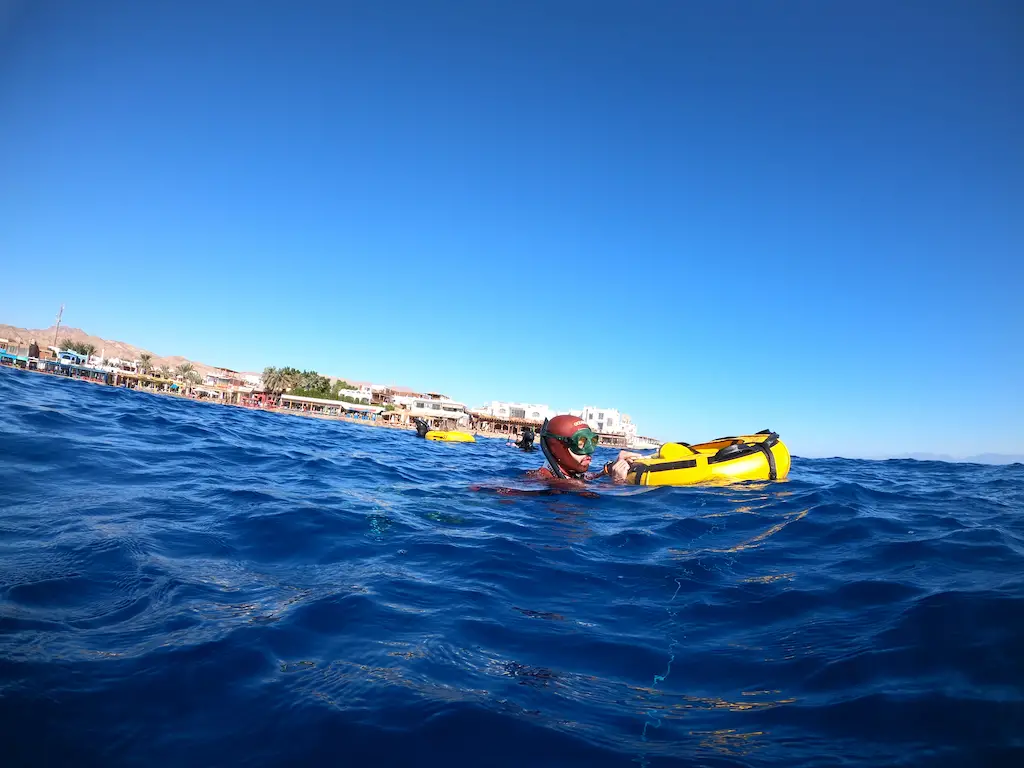
One of my favourite spots to freedive in Dahab is at the Lighthouse. A protected bay right in the main part of town, entirely surrounded by restaurants and caffe bars.
The vibe here is out of this world. You choose your caffe/resto-bar, pick a lounge-style table, and get changed into your freediving gear. Once you’re done, you can find a nice warm breakfast and coffee waiting for you at your table.
Tip #5: Get a 5-10 meter (15-30 feet) surface line that floats and is visible in order to tether to other buoys or on a fixed point (i.e. mooring).
The access to depth is also quite impressive. Access to 40 meters (130 feet) is about a one minute swim from shore. With moorings every 10 meters (35 feet) deep, you can easily dive here up to 50 meters (165 feet). There’s even a 70 meter (230 feet) mooring for deeper dives. Every buoy is tethered to another, that way you have a string of buoys will plenty of freedivers around.
If you need a buddy, instructor/coach, gear or a diving setup, Dahab Freedivers is located right on the waterfront. Feel free to reach out to them.
Miguel Lozano’s Training Camp
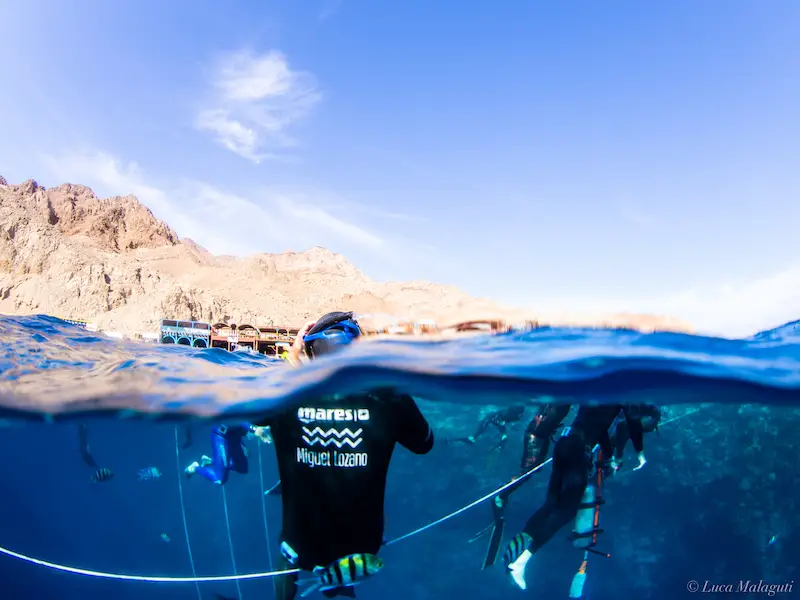
First time ever in the Blue Hole I got to step in with Miguel Lozano on the last day of his advanced skills training camp.
Miguel is a very deep freediver, with a Free Immersion dive to – 122 meters (400 feet) on one breath. Miguel is also one of the owners of the well-established freediving school Dahab Freedivers. His training camp focused on skills including deep equalization, mental relaxation and mouthfill techniques. These are important skills to have when diving deep, and well below one’s Residual Volume (RV).
Tip #6: Learning proper equalization techniques and mouthfill management are key skills for advancing deep in freediving. Reaching out to an experienced coach can really help you improve.
Keep an eye out for his well-known training camps in Dahab. They occur a few times a year and are very popular among the freediving community.
No Limits Training in the Blue Hole
Miguel’s students were also testing out their skills in No Limits diving by using the weighted sled. How would this setup work?
First, an instructor would accompany you to a set depth. One reached, they would fill the lift bag by opening the compression air cylinder strapped to the sled. The lift bag would bring the divers bag to the surface.
This was my first time witnessing the No Limits in action, and I was quite impressed. I was also fortunate to be the “behind-the-scene” photographer for the official event photographer Federico Buzzoni. This is quite enjoyable since you can experiment while not being stressed to deliver perfect photos to clients.
Tip #7: If you’re keen on freediving photography, having a short, agile and powerful fin like the Alchemy V3-30 PROs is perfect for the job. I also recommend white footpockets to adjust the white balance underwater.
I discuss white footpockets being really useful for freediving photography in this article here.
Picture below: watching a No Limits dive in action! Check out how the photographer sets himself up for a shot while being in the positive buoyancy zone.
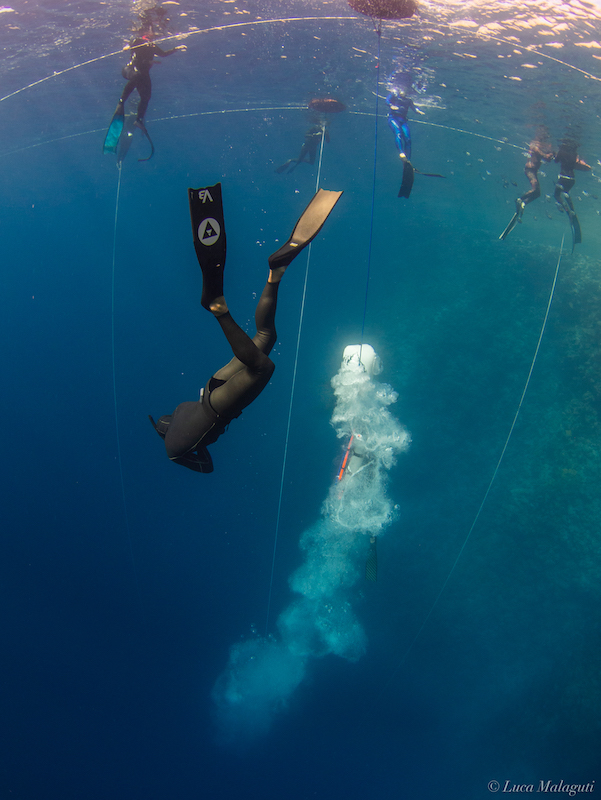
Dahab Climbing
Hidden Wonders in the Desert
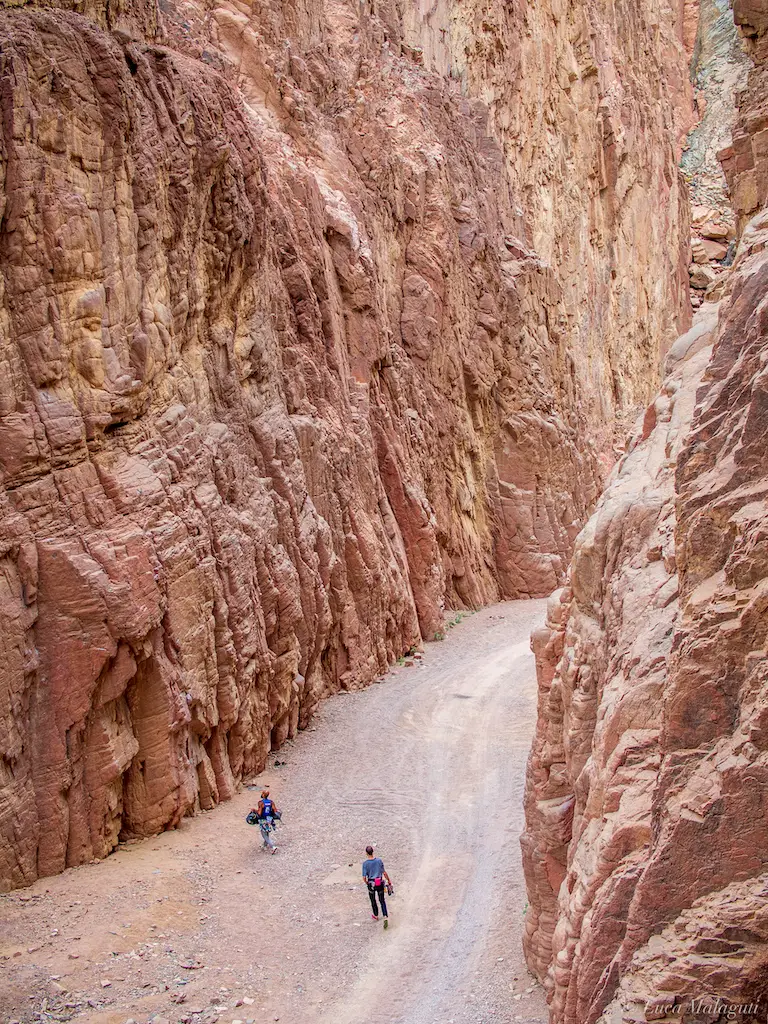
Need to take a break from the ocean?
Dahab offers much more than just freediving. If you’re looking for a fun activity that involves both a physical and mental component, rock climbing is your answer.
Dahab offers epic sport climbing and bouldering. Some route are also set for traditional (i.e. “trad”) climbing, but please be aware of some key points:
- Some routes were set a while ago, so they could easily be “sand-bagged”. In other words, much harder than announced.
- Over-head hazards. This is not Squamish or Yosemite. The granitic rock here is heavily weathered and “chossy”. Please be aware of things falling.
- The climbing grades follow the French System, and not the American “Yosemite Decimal System”.
- Please hire a taxi driver that knows the area well. Connect with a local guide and climber (read below).
- Bring all the supplies you need, including warm clothes and water.
- Check the bolts before committing to an anchor or a route. Some have been there for a while.
Tip #8: Buy a locally made carpet when you go in the desert. They cost about 100-150 Egyptian Pounds (6-9 USD) and are fantastic while resting or having a pic-nic during a day of climbing.
I met Amira on the first day out climbing through friends in climbing. Amira Helmy is an awesome climber and guide. Her passion is to inspire women in Egypt and the Middle East to go out and climb. She’s happy to take everyone, locals and tourists alike, on some epic adventures.
Message Amira if you’d like to explore this magical climbing paradise.
If you’re new to climbing, like freediving, don’t take risks in the middle of nowhere, connect with a local pro.
Freediving and Rock Climbing
Controlling the breath and relaxation
What I love about the combination of freediving and climbing: the interplay between mind and body.
These two sports actually have quite a lot in common. Yes, their “environmental mediums” couldn’t be anymore different. In freediving, you go down in water. In climbing, you go up on rock or ice.
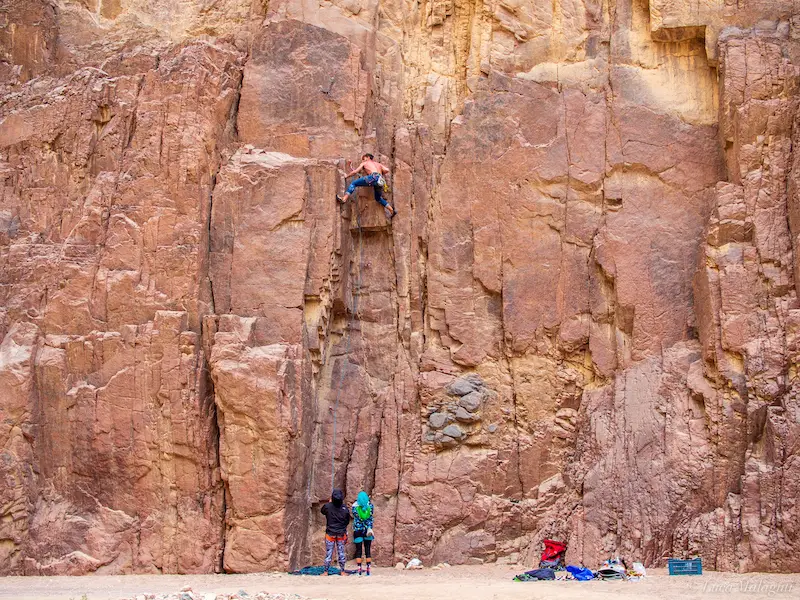
I wrote a very detailed article about the similarities of freediving and ice climbing. You can read it here.
In both climbing and freediving, it all comes down to your breathing: before, during and after. Controlling your breath is key to relaxing, not panicking and remaining calm in a difficult situation.
Tip #9: Slow down your breathing when climbing, as well as in freediving (i.e. breath-up). If you find yourself “panicked” or stressed, focus on the movement of air in and out of your nostrils. Take long and deep breaths through the nose.
Visualization techniques
The way you develop a focus in freediving is very similar to rock climbing. Often, we refer to this as “narrow-based focus”. Visualization techniques are heavily used in both sports.
Freediving visualization involves creating a detailed plan of every perfectly executed move in your mind. Rock climbers do the exact same. Studying each foot-hold and movement of the hands prior to touching the rock. Visualization the ideal execution of each movement in the mind before it ever happens. This helps it become a reality.
Narrow-Based Focus
The “narrow-based focus” approach is a technique to tackle a large and difficult task and break it down in simple steps. The mind can overload and collapse when faced with a seemingly “impossible” task (i.e. like diving deep on one breath or climbing a huge wall).
Tip #10: The mind thinks, the body follows. First, you must complete the task in your mind, and in a way the brain can handle. The body will follow in action.
However, the “narrow-based focus” tells us to take a big task and break it down into smaller tasks. This way the mind can focus on one small thing at a time, rather than a monumental task.
Approach in freediving
In freediving, don’t think about having to dive to 40 meters (130 feet) on one breath. Rather, think about completing the first 10-20 meters (30-65 feet) by counting movements with consistent equalization. Here, your goal is to get to 20 meters with good technique. Don’t look down at what’s left to go!
Then, from 20-30 meters (65-100 feet), focus on slower movements and relaxing parts of the body not utilized. Surprisingly, you get to 30 meters without any effort and you’re still relaxed. Finally, if you’re feeling good, enjoy the free-fall to 40 meters (130 feet) without any expectation to get there. The 40 meter mark should almost “surprise” you. You tell yourself; ” Wow! That was easy”.
Approach in climbing
In climbing, it’s quite similar. Never look up and tell yourself “I have to climb that 30 meter (100 foot) wall”. Break down the climb into smaller stories, or narratives, each one with a unique journey of movements. Once you reach a bolt, rest, chalk-up and further analyze the next 2-3 movements to come. Don’t look up at what’s ahead, what’s left to go! Simply focus on the next few moves, until you reach a feature you’ve studied. Rest here, breathe, and move on to the next sequence of moves.
The journey is long, so approach it one goal at a time.
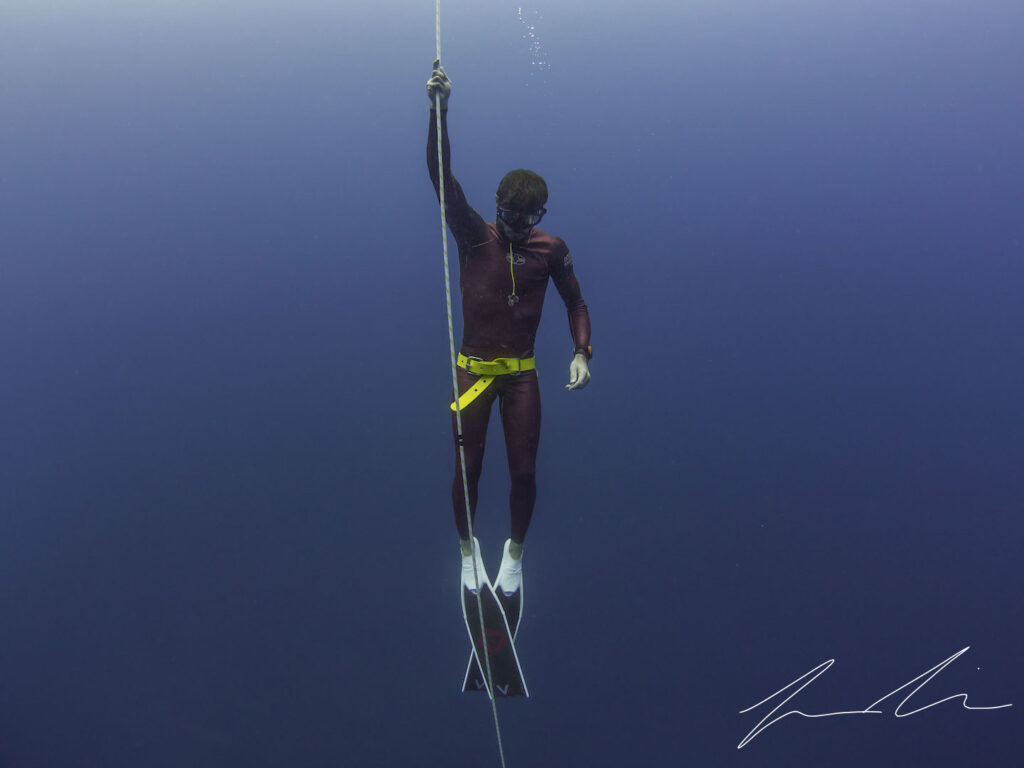
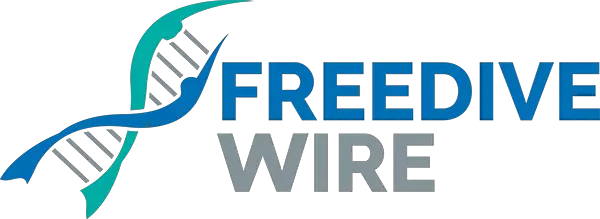
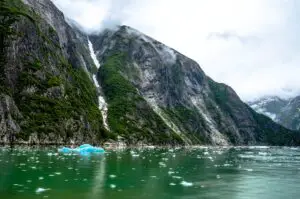
Awesome stuff!
Thanks for your work!
Keep going!
Greetings from Freediving Masterclass
Thanks!!